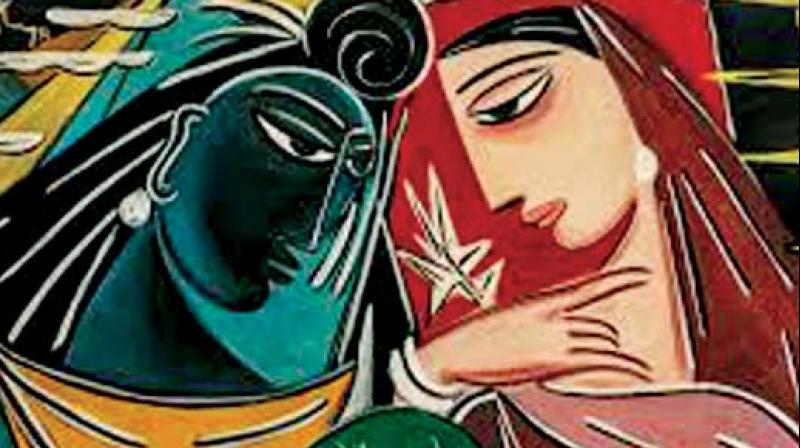Sri Lanka's Picasso, Yashodhara Dalmia's passion

George Keyt (1901 - 1993) is rightly regarded as an icon of modern art, a demi-God in Sri Lanka. A Cubist painter, Keyt’s works have often been compared with the likes of Picasso (entrenched as they are in mythology from the subcontinent) and his contemporary, Henri Matisse. Still, running a google search for an interview of the man throws up surprisingly few results, save for an obituary written by his dear friend, Martin Russell. Much is known about Keyt the painter, although his personal life, despite his naturally gregarious nature and his love for writing, remains a mystery. It was precisely this sense of inscrutability that drew Delhi-based art historian and biographer, Yashodha Dalmia (who was last in town for the exhibition, Amrita Sher-Gil, The Passionate Quest, which she curated) to consider writing a biography on Keyt. Her book, Buddha to Krishna: 'Life and Times of George Keyt tells the story of the man behind the paintings and will be launched in Delhi next week.
"It took me about five years to research," said Dalmia, who is the author of several books on art, including The Making of Modern Indian Art and Amrita Sher-Gil - A Life. She began at his place of origin, traversing every inch of Sri Lanka to find all she could about the man. "I saw collections and travelled around, meeting people who knew him." Keyt had been a prolific letter writer, but her travels in Sri Lanka didn't throw up much. "For some reason or the other, people didn't come forth with his correspondences.
It was in London that Dalmia finally struck gold. "Martin Russell had amassed an archive during his lifetime," she said. It was through his son Julian that Dalmia found what she had been looking for - a veritable treasure trove of letters, memorabilia and photographs. It was on the basis of this that I could write my biography." The letters, she said, are monumental in the field of literature, too - Keyt was a prolific writer and published two books of poetry, Darkness Disrobed and Image in Absence, before he took to painting. "He started painting when he was around 26, before which he was a poet," Dalmia explained.
Keyt’s role in the context of modern art is pivotal. In 1947, Dalmia said, he had a show at the Convocation Hall in Mumbai, just before the progressive artists' group w as formed there. "Artists like Souza, Husain and Raza knew him, it's only fitting that his name is inscribed in the making of modern art in India. Moreover, the importance he held for India was tremendous," said Dalmia. Not only did he have his first show here, he was bewitched by Indian mythology, a love he made apparent in his art.
A Burgher (member of an Eurasian ethnic group in Sri Lanka), Keyt’s ancestor, according to legend, was a British soldier in Mumbai who fell in love with a daughter of the Nizam. “This was not appreciated,” Dalmia remarked, “And the two of them ran away to Sri Lanka, where Keyt was born.” Raised a Catholic, Keyt was firmly rooted in the culture of the subcontinent, even considering, at one point, being a Buddhist monk. “He was dissuaded, by a monk.”His interest in oriental religion and his close ties with India sparked a deep fascination for the Hindu scriptures – he went on to translate the Gita Govind from Sanskrit, along with his brother-in-law. "He believed that every religion had something to offer," said Dalmia. "All his work is very modern but belongs here, somehow."
All this requires a great deal of study – “He chose to live quietly in a village, away from the bustle of the city,” she said. Despite his attempts at solitude, no trip to Sri Lanka was deemed complete without Keyt’s residence being paid a visit. "He was alone, but never isolated. Anyone who visited sri Lanka went to see him, he was a true icon, in that sense." The visitors included actress Vivien Leigh, who bought his paintings, Chilean poet Pablo Neruda, who later wrote, "Keyt I think is the living nucleus of a great painter," and the British writer Evelyn Waugh, whose account (a letter to his wife) has been recorded in Dalmia’s book.
“It was a great learning experience for me. Firstly, Sri Lanka amazed me. It’s so close to us, but different in so many ways,” said Dalmia. Learning about Keyt and the forces that drove him was another revelation too. “"He was unfailingly honest, about other people and also about himself. It was this honesty, this objectivity, that allowed him to look at his own works and appraise them.” That’s not all. “What struck me most? Keyt was a survivor, one of great courage, strength and creativity, who continued to paint until the very end. It enriched everybody around him. He stands tall in the world, not just of art, but as a man."

